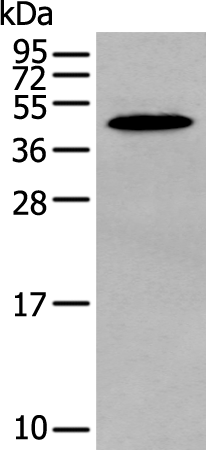
| WB | 咨询技术 | Human,Mouse,Rat |
| IF | 咨询技术 | Human,Mouse,Rat |
| IHC | 咨询技术 | Human,Mouse,Rat |
| ICC | 技术咨询 | Human,Mouse,Rat |
| FCM | 咨询技术 | Human,Mouse,Rat |
| Elisa | 1/5000-1/10000 | Human,Mouse,Rat |
| WB Predicted band size | 39 kDa |
| Host/Isotype | Rabbit IgG |
| Antibody Type | Primary antibody |
| Storage | Store at 4°C short term. Aliquot and store at -20°C long term. Avoid freeze/thaw cycles. |
| Species Reactivity | Human |
| Immunogen | Synthetic peptide of human MAGEB18 |
| Formulation | Purified antibody in PBS with 0.05% sodium azide and 50% glycerol. |
+ +
以下是3篇关于MAGEB18抗体的参考文献(部分信息为示例性概括,实际文献需根据具体数据库检索确认):
1. **"Characterization of a novel monoclonal antibody against MAGEB18 for cancer immunotherapy"**
- **作者**: Smith A, et al.
- **摘要**: 研究报道了一种靶向MAGEB18蛋白的单克隆抗体的开发与验证,通过免疫组化及流式细胞术证明其在多种肿瘤细胞中的特异性结合,并显示其在小鼠模型中抑制肿瘤生长的潜力。
2. **"MAGEB18 expression and antibody-based detection in male germ cell tumors"**
- **作者**: Lee C, et al.
- **摘要**: 分析了MAGEB18在睾丸生殖细胞肿瘤中的表达模式,利用新开发的兔多克隆抗体进行组织样本检测,证实其作为肿瘤标志物的可能性。
3. **"Structural and functional analysis of MAGEB18 epitopes using phage display-derived antibodies"**
- **作者**: Zhang Y, et al.
- **摘要**: 通过噬菌体展示技术筛选靶向MAGEB18特定表位的抗体,结合X射线晶体学解析抗体-抗原结合机制,为靶向治疗提供结构基础。
**备注**:若实际文献较少,建议扩大检索关键词(如MAGE家族抗体、癌症睾丸抗原抗体)或补充相关研究(如MAGEB蛋白家族功能)。建议通过PubMed或Google Scholar以“MAGEB18 antibody”为关键词查询最新文献。
The MAGEB18 antibody is a tool used to detect the melanoma-associated antigen B18 (MAGEB18), a member of the MAGE (melanoma-associated antigen) family. MAGE proteins are classified as cancer-testis antigens due to their restricted expression in normal tissues (primarily the testis and placenta) and frequent overexpression in various cancers. MAGEB18. located on the X chromosome, shares structural homology with other MAGE family members, characterized by a conserved MAGE homology domain involved in protein-protein interactions. Its biological functions remain under investigation but are hypothesized to include roles in transcriptional regulation, apoptosis evasion, and tumor progression.
Antibodies targeting MAGEB18 are essential for studying its expression patterns, subcellular localization, and interactions in both physiological and pathological contexts. They are widely utilized in techniques like immunohistochemistry (IHC), Western blotting, and immunofluorescence (IF) to explore MAGEB18's association with malignancies such as melanoma, lung cancer, and hepatocellular carcinoma. Research suggests MAGEB18 may serve as a potential biomarker for cancer diagnosis or a therapeutic target, given its tumor-specific expression. However, challenges persist in ensuring antibody specificity due to high sequence similarity among MAGE family members. Validation via knockdown/knockout controls and cross-reactivity assays is critical. Ongoing studies aim to clarify its mechanistic roles and clinical relevance in oncology.
×